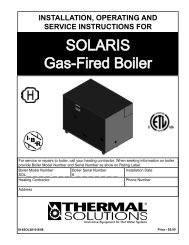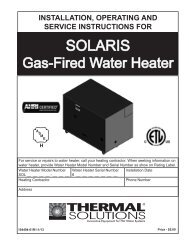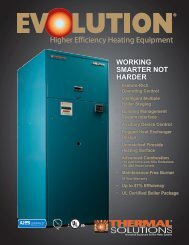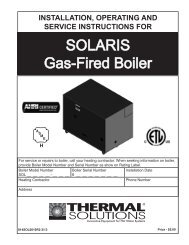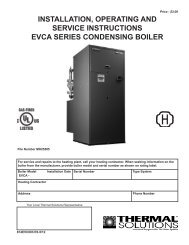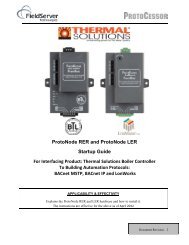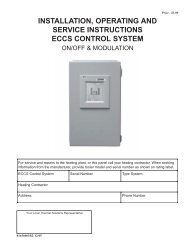installation, operating and service instructions eva series boiler
installation, operating and service instructions eva series boiler
installation, operating and service instructions eva series boiler
You also want an ePaper? Increase the reach of your titles
YUMPU automatically turns print PDFs into web optimized ePapers that Google loves.
7. Electrical<br />
a. Each <strong>boiler</strong> must be provided with a dedicated<br />
fused disconnect.<br />
b. Install wiring <strong>and</strong> ground <strong>boiler</strong> in accordance<br />
with requirements of authority having<br />
jurisdiction. In absence of such requirements,<br />
the National Electrical Code, ANSI/NFPA 70<br />
<strong>and</strong>/or CSA C22.1 Electrical Code.<br />
c. Install each circulator with a separate fused<br />
disconnect switch. Refer to circulator<br />
manufacturer's data for electrical requirements.<br />
d. Refer to Figure 1 for electrical data for each size<br />
<strong>boiler</strong>.<br />
8. Condensate Piping<br />
NOTICE<br />
Do not install <strong>boiler</strong> <strong>and</strong> circulator pump on<br />
the same fused disconnect.<br />
a. Each <strong>boiler</strong> requires separate condensate drains.<br />
In addition, most venting configurations require<br />
separate condensate drains in the vent system.<br />
Do not manifold <strong>boiler</strong> drains or vent drains<br />
together.<br />
b. Refer to Section G for condensate removal<br />
system.<br />
G. CONDENSATE DRAINS<br />
1. Each <strong>boiler</strong> contains a condensate drain. In<br />
addition, most vent configurations require a drain<br />
tee located in the vent piping. Pipe each condensate<br />
drain separately to a floor drain or condensate pump/<br />
sump.<br />
2. Use continuous Teflon or high temperature resistant<br />
silicone tubing for condensate piping. Do not install<br />
fittings on condensate lines.<br />
4. A common condensate pump/sump may be used.<br />
Run separate piping from each condensate drain<br />
to the sump. A common drain may be used to<br />
discharge condensate from the sump. Consult<br />
pump/sump manufacturer for compatibility of<br />
pump/sump materials of construction. If a common<br />
sump is used, individual drain lines should be<br />
connected such that one drain cannot back feed into<br />
another drain.<br />
5. Consult local authorities regarding disposal of flue<br />
gas condensate into public waste water system.<br />
Some jurisdictions require that the condensate<br />
be buffered before discharge. This buffering is<br />
commonly achieved by draining the condensate<br />
through a limestone bed. Consult a chemical<br />
treatment company for buffering systems.<br />
CAUTION<br />
D o not use P V C , C P V C or any other non<br />
Teflon or non high temperature resistant<br />
s ilic o n e b a s e d ma te ria l fo r c o n d e n s a te<br />
piping.<br />
CAUTION<br />
Failure to properly pipe condensate system<br />
will greatly reduce <strong>boiler</strong> life. Do not install<br />
plugs, caps or valves on condensate<br />
piping. Do not connect condensate drains<br />
together. Do not reduce size of condensate<br />
piping.<br />
3. Each condensate drain must contain a siphon/pigtail<br />
to prevent flue gas flow through the condensate<br />
piping.<br />
35



